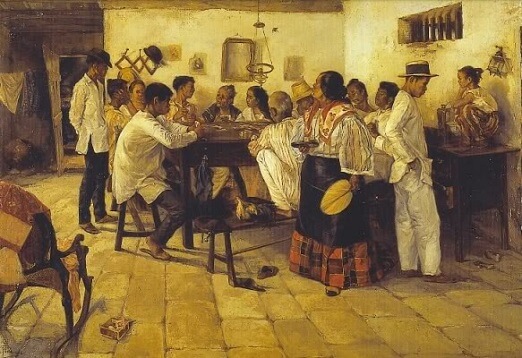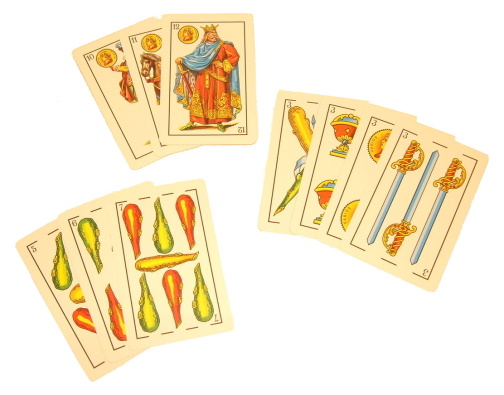|
Listen to this Gambling History blog post here
Getting your Trinity Audio player ready...
|

Though its popularity declined since its heyday, panguingue rightfully earned a place in United States gambling history. Great, but what the heck is it?
Panguingue, or pan for short, is a rummy-type gambling card game. In fact, it descends directly from conquian, the patriarch of all rummy games. Pan calls for six, seven or eight players ideally but any number may play. Chips are used for wagering and scorekeeping.
Southeast Asia Origin
Panguingue is thought to have originated among the Tagalogs, natives of the island of Luzon in the Philippines, during the country’s Spanish period, between 1565 and 1898.
“Panguingue,” pronounced “pan-ginn’-gay,” is the English language version of the original Tagalog word, “pangginggi” or “pangguinggui.”
Pops Up in the U.S.
Pan was staple of the gambling halls during the California Gold Rush in the mid-1800s and made its way to Nevada, Arizona, Washington and other western states.
The game often was played to pass the time, in bordellos, for example, by ladies of the evening while waiting for customers, and in gambling and pool halls, by laborers away from home.
It reportedly was in those prostitution houses that a unique, sexually suggestive lingo for pan developed. For example, “getting down” refers to placing a bet. The “tops” are the penalty chips players pay for opting not to play a round; the tops go to the round winner. “Being peckered,” is when a player, during a round, can’t make a play called a wagon (two of three cards in a spade valle card meld — see below for explanation) with a matching spade.
In Nevada, panguingue occasionally was found in the casinos throughout much of the 20th century, according to David Schwartz, author of Roll The Bones. In California, the Anti-Gambling Act passed in 1860 outlawed all games of chance in which bets are placed against a house, bank or dealer. Thus, panguingue was and, since, has been allowed.
Generally, though, pan didn’t catch on in the States to the same extent of its cohorts — faro, poker and blackjack/21. That may have been because some games of chance players found it boring.
“Panguingue, to some persons, is a dull and deadly game. Many do not see anything to get excited about, at least from a gambling angle,” The Spokesman-Review noted (Feb. 1, 1935).
Part of American Culture
The game is said to have been first recorded as part of American lexicon in 1905, in the Dictionary of American Regional English.
Another early reference, according to a Miami Herald columnist (Aug. 19, 1945), was in the 1910 book published in Manila, When the Krag is Laid Away, by Chancey McGovern. The passage read: “… when the mujer of the house was too busily preoccupied with the intricacies of panguingue [sic]. (The Filipina woman’s national game. As much as ten cents is lost by some unfortunate housewife in a single afternoon’s playing.)”
Card Deck Variations
For pan games in the Philippines, players used 8 Spanish, 40-card decks, each comprising four suits of these ranks: 1, 2, 3, 4, 5, 6, 7, Jack, Cavalier and King.
Typically in the U.S., the same number of 52-card decks were used but the 8s, 9s and 10s were removed so they included only and all ranks equivalent to those in a Spanish deck.
The number of decks used, however, could vary, often by locale. In the state of Washington, for instance, 10 was the norm.
Sometimes, players removed additional suits from the decks to change the odds. Along with the 8s, 9s and 10s, they may have excluded one suit of spades, one suit of spades and the 3s, 5s and 7s, etc. Historically, throughout California, for example, eliminating two suits of spades from each deck was common.
The Game Rules
Each player antes up 1 chip.
Rotating to the right (versus the more common left), each player is dealt 10 cards, 5 at a time. The remaining cards are placed face down, forming the draw pile. The top card is flipped over, face up, next to the draw pile, to start the discard pile.
Next, every player, again to the right, decides to stand (play) or drop (fold). The droppers forfeit their ante, pay the tops and place their cards at the bottom of the draw pile.
The game objective is to create melds with one’s cards. The first player to meld 11 cards wins the round.
Possible melds are a) 3 cards of the same rank in the same suit; b) 3 cards of the same rank in different suits; and c) 3 consecutive cards in the same suit. With rank melds, aces and kings are the exception; any 3 form a meld.

A winning pan hand
To play, each player draws 1 card, either from the top of the draw pile or the top of the discard pile. With a card from the draw pile, the player must immediately incorporate it into a meld and place the meld face up on the table (an open meld). If he can’t do so, he must place the card face up on the discard pile.
If the player chooses a card from the discard pile, it must be added to an open meld. Otherwise, it must be discarded.
Caveats: If the card discarded by the previous player is one that fits an open meld of the in-turn player, the in-turn player must draw and use that card.
On every turn, players must discard a card so they always have exactly 10 cards in hand, except on a winning turn when they must have 11.
When a player wins a round, he/she collects the tops, the pot and chips from every other active player according to these conditions:
- For melds of valle, or value, cards (3s, 5s and 7s) in different suits: 1 chip
- For meld of valle cards in the same suit: 4 chips for spades, 2 for others
- For melds of non-valle cards in the same suit: 2 chips for spades, 1 for others
- For melds of 3-2-Ace or King-Queen-Jack: 2 chips for spades, 1 for others
For more comprehensive coverage of the game rules, refer to The Great Panguingue Blog, Hoyle’s Rules of Games or, if available, Peter Burke’s How to Play Pan (Panguingui), the World’s Most Fascinating Card Game (1941).
Have you ever played pan? What do you think of it?






